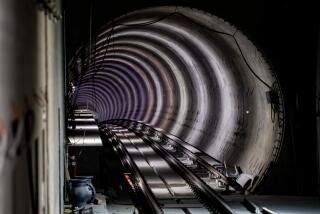PERSPECTIVES ON PUBLIC TRANSIT : Commuting on the Backs of the Poor : Metrolink subsidies widen the distance between the suburban ‘haves’ and the urban, bus-riding ‘have-nots.’
The stark contrast in the transit service provided to upper-middle-income train riders and lower-income bus riders reveals a pattern of inequity that is quickly creating a two-tier public transit future for Los Angeles.
This inequity is easily demonstrated by taxpayer subsidies. The entire 400-mile Metrolink system serving Ventura, Los Angeles, Orange, Riverside and San Bernardino counties initially cost $800 million. The ridership when it is fully operational in 1995 is optimistically projected to be 40,000 per day. The total taxpayer subsidy will range from $10 to $16 per ride. The total annual subsidy will be roughly $160 million to $170 million. If the present trend of ridership continues, we will be looking at subsidies of $40 to $50 per ride in 1995.
The regional bus system, on the other hand, carries more than 1.3 million passengers daily and receives an average subsidy of about $1 per ride.
The disparity in subsidies is not limited to Metrolink. The Blue Line between downtown Los Angeles and Long Beach, which carries 36,000 daily, receives about $11 in subsidy per rider. The Blue Line subsidy includes $13 million annually for security, more than the entire transit police budget for protecting bus riders countywide.
The recession has created a $117-million shortfall at the Southern California Rapid Transit District, which has been reduced to $59 million by slashing money set aside for bus service expansion. After a great deal of public outcry over possible fare increases and service cuts, the Los Angeles County Transportation Commission agreed last week to fund $40 million more of the deficit.
In recognition that RTD is already the most overcrowded bus system in the country, carrying nearly 20% more passengers per bus than in New York City, the LACTC agreed to apply any savings to relieving overcrowding.
When we should be concentrating on “rebuilding L.A.” and lessening the gap between the “haves” and “have-nots,” the LACTC has turned its back on the inner-city transit-dependent in favor of high-tech rail service for more well-to-do suburbanites. This may be smart politics on the short end, but is a recipe for disaster in the long run.
Rail transit is the centerpiece of LACTC’s 30-year transportation plan. Public transit money would be more prudently spent on building a first-class bus system, with clean, efficient, dependable service. At a bare minimum, basic bus service should not be allowed to deteriorate further and fares should not be raised. In a time of cuts, the rail, not the bus, should take the back seat.
More to Read
Sign up for Essential California
The most important California stories and recommendations in your inbox every morning.
You may occasionally receive promotional content from the Los Angeles Times.










